Welcome students to an amazing analysis of this chapter on ‘Human Environment Interactions – The Tropical and the Subtropical Region. We have presented these solutions in a simple and interesting manner to ensure that you enjoy going through them.
Find NCERT Solutions for Class 7 Social Studies (Geography) Chapter 8 ‘Human Interactions – The Tropical and the Subtropical Regions’, here:
1. Answer the following questions.
(i) Name the continent in which the Amazon Basin is located.
Answer:
The Amazon Basin is located in South America.
(ii) What are the crops grown by the people of the Amazon Basin?
Answer:
The crops grown by the people of the Amazon Basin are mainly tapioca, pineapple and sweet potato. They also grow cash crops like coffee, maize and cocoa. The staple food is manioc also known as cassava which grows under the ground.
(iii) Name the birds that you are likely to find in the rainforests of the Amazon.
Answer:
The birds that are likely to be found in the rainforests of the Amazon are toucans, humming birds and the birds of paradise with their brilliantly coloured plumage and oversized bills. The birds make loud sounds in the forest.
(iv) What are the major cities located on the River Ganga?
Answer:
The major cities located on the river Ganga are Allahabad, Kanpur, Varanasi, Lucknow, Patna and Kolkata – all with a population of more than ten lakh.
(v) Where is the one-horned rhinoceros found?
Answer: The one-horned rhinoceros is found in the Brahmaputra Plain of Assam. The grassy plains with bamboo groves are an ideal habitat for one-horned rhinoceros.
2. Select the correct answer.
(i) Toucans are a type of
(a) birds
(b) animals
(c) crops
Answer: (a) birds
(ii) Manioc is the staple food of
(a) Ganga Basin
(b) Africa
(c) Amazon
Answer: (c) Amazon
(iii) Kolkata is located on the river
(a) Orange
(b) Hooghly
c) Bhagirathi
Answer: (b) Hooghly
(iv) Deodars and firs are a type of
(a) Coniferous trees
b) Deciduous trees
(c) shrubs
Answer: (a) Coniferous trees
(v) Bengal tiger is found in
(a) Mountains
(b) Delta area
(c) Amazon
Answer: (b) Delta area
3. Match the following.
| (i) Cotton Textile | (a) Assam |
| (ii) Maloca | (b) Terrace farming |
| (iii) Piranha | (c) Sericulture |
| (iv) Silkworm | (d) Slanting roof |
| (v) Kaziranga | (e) Ganga plain |
| (f) Varanasi | |
| (g) Fish |
Answer:
| (i) Cotton Textile | (f) Varanasi |
| (ii) Maloca | (d) Slanting roof |
| (iii) Piranha | (g) Fish |
| (iv) Silkworm | (c) Sericulture |
| (v) Kaziranga | (a) Assam |
4. Give reasons.
(i) The rainforests are depleting.
Answer:
The biologically diverse rainforests are depleting because of large-scale development activities which are going on in the Amazon basin. Highways are being built, aircrafts and helicopters are also used for reaching various places. Deforestation has increased due to which the topsoil of land is getting washed away turning the lush green forest into a barren landscape.
(ii) Paddy is grown in the Ganga-Brahmaputra plains.
Answer:
Paddy is grown in the Ganga-Brahmaputra plains because the climactic conditions and soil are ideal for the growth of paddy. The fertile alluvial soil and the extensive flat land are suitable for the production of paddy. The region has ample rainfall which is essential for paddy to thrive as it requires sufficient water for growth.
5. Map skills
(i) On an outline map of the Indian Sub-continent, draw the rives Ganga and Brahmaputra from the source to the mouth. Also show the important tributaries of both rivers.
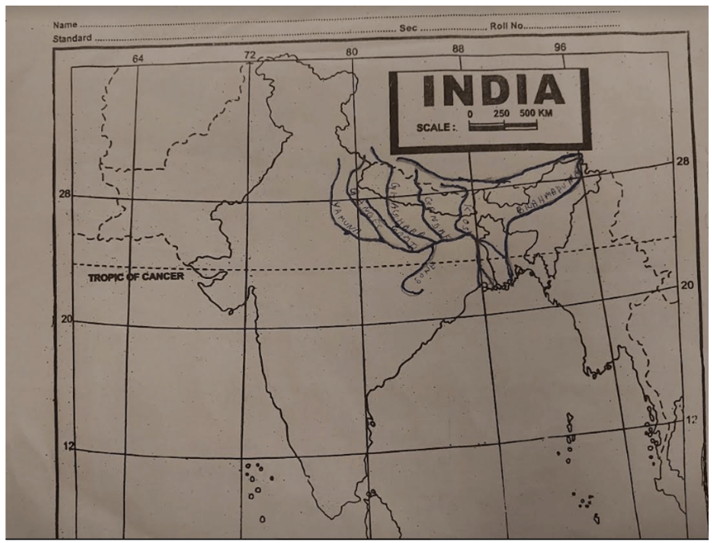
(ii) On a political map of South America, draw the equator. Mark the countries through which the equator passes.
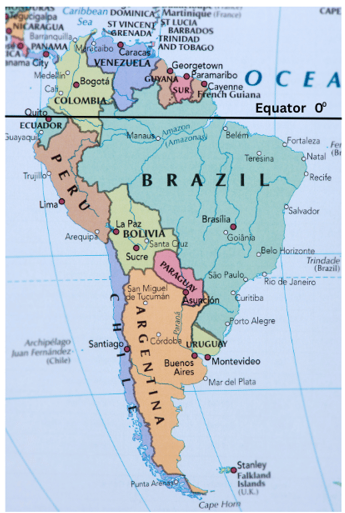
6. For Fun:
Make a collage to show places of attraction in India. You can divide the class in different groups to show attractions based on mountain landscapes, coastal beaches, wildlife sanctuaries and places of historical importance.
Mountainscape
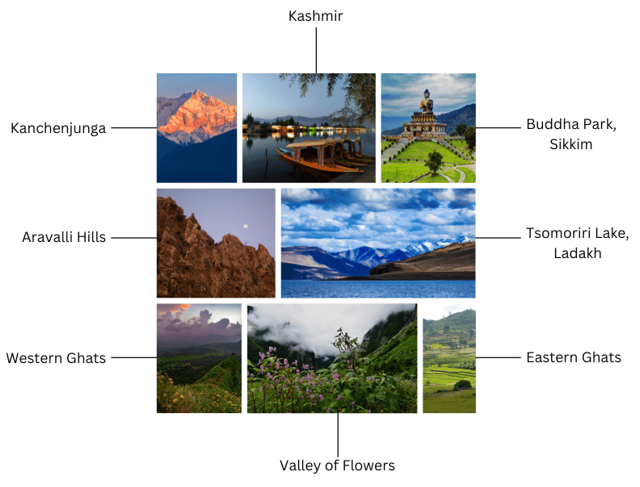
Coastal beaches
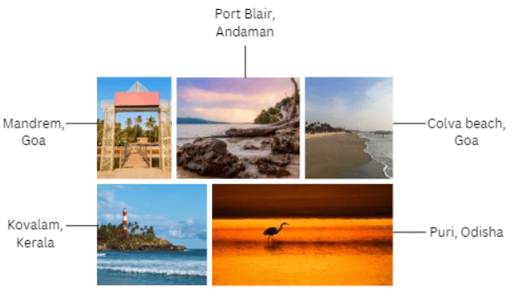
Wildlife Sanctuaries
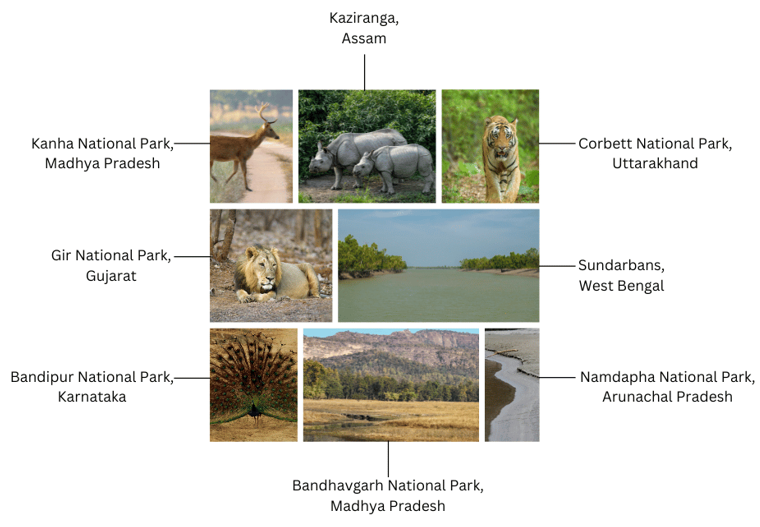
Places of Historical Interest
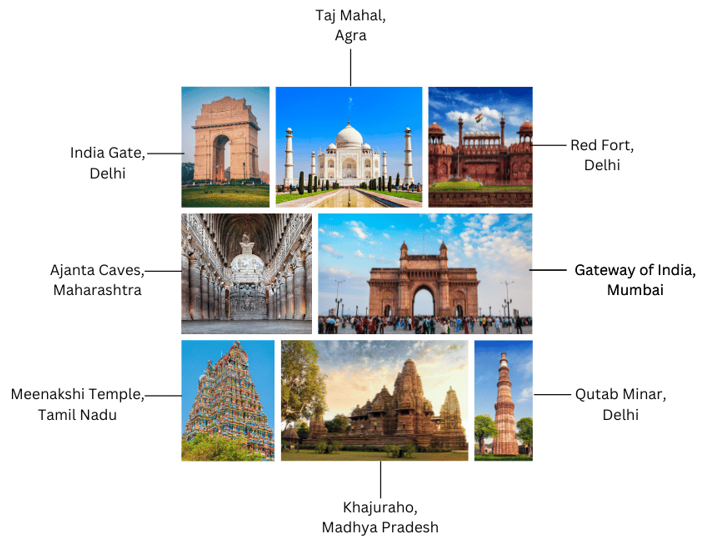
7. Activity.
Collect under mentioned material and observe how destruction of trees effect the soil cover.
Material
(i) Three small flowerpots or food cans (e.g., cold drinks tin cans),
(ii) one big can with holes punched in the bottom (this will act as a sprinkling can),
(iii) twelve coins or bottle caps
(iv) soil.
Steps
Take three small cans or pots. Fill them with soil till the top. Press the soil to make it level with the top of the can. Now put four coins or bottle caps on the soil of each can. Take the big can that has been punched with holes and fill it with water. You can also take the sprinkling can from your garden. Now, sprinkle water on the three cans. On the first can sprinkle water very slowly so that no soil splashes out. Let moderate amount of water be sprinkled on the second can. On the third can, sprinkle the water heavily. You will observe that unprotected soil splashes out. Where the ‘rain’ is heavy the amount of soil that splashes out is the maximum and least in case of the first can. The coins or caps represent the tree covers. It is clear that if the land is cleared completely of the vegetation, the soil cover will quickly disappear.
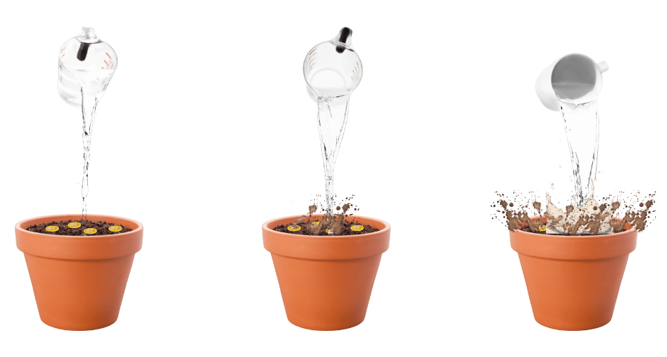
Solutions for In-Text questions of NCERT Class 7 Geography Our Environment Chapter 6 ‘Human Environment Interactions- The Tropical and the Subtropical Region”
Text Book Page no 40
1. Name the countries of the basin through which the equator passes.
Answer:
The countries of the basin through which the equator passes are Ecuador, Colombia and Brazil.
Text book Page no 44
2. River Brahmaputra is known by different names in different places. Find the other names of the river.
Answer:
The river Brahmaputra is known by different names in different places as listed below:
- Yarlung Tsangpo in Tibet
- The Siang/Dihang in Arunachal Pradesh
- Brahmaputra or Luit in Assam
- Jamuna in Bangladesh
Text Book Page no 44
Collect some handicrafts made from jute, bamboo and silk. Display them in the class. Find out in which area they were made?
Answer:
Jute, bamboo and silk are made in Bihar, West Bengal and Assam.
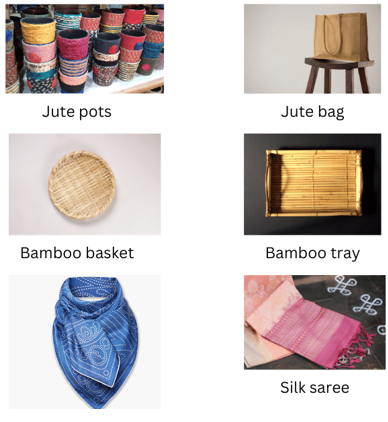
Extra Questions NCERT Class 7 Geography Our Environment Chapter 6 ‘Human Environment Interactions -The Tropical and the Subtropical Region”
A. Multiple Choice type Questions (MCQ)
1. What are the basic needs of human beings irrespective of where they live?
(i) food
(ii) clothes
(iii) shelter
(iv) All of the above
2. Name the country through which the equator does not pass.
(i) Venezuela
(ii) Ecuador
(iii) Brazil
(iv) Columbia
3. Which country is not drained by the Amazon?
(i) Peru
(ii) Bolivia
(iii) Argentina
(iv) Brazil
4. How is the climate of the Amazon basin best described?
(i) cold and damp
(ii) hot and wet
(iii) Hot and dry
(iv) None of the above
5. Which animals would you not find in the rainforest
(i) monkey
(ii) sloth
(iii) giraffe
(iv) tapir
6. Which crops do the Amazonian women grow?
(i) paddy
(ii) wheat
(iii) maloca
(iv) manioc
7. Anaconda is a kind of _____________.
(i) tropical bird
(ii) deadly fish
(iii) reptile
(iv) None of the above
8. Where is the one-horned rhinocerous found?
(i) In Africa
(ii) In the Amazon basin
(iii) In the Brahmaputra plain
(iv) In Australia
9. What is a bromeliad?
(i) a plant parasite
(ii) a plant that stores water in its leaves
(iii) a plant which provides a place for frogs to lay eggs
(iv) all of the above
10. Which city is not located on the river Ganga?
(i) Allahabad
(ii) Varanasi
(iii )Agra
(iv) Kanpur
Answers:
1. (iv) All of the above
2. (i)Venezuela
3. (iii) Argentina
4. (ii) hot and wet
5. (iii) giraffe
6. (iv) manioc
7. (iii) reptile
8. (iii) In the Brahmaputra plain
9. (iv) all of the above
10.(iii )Agra
B. Fill in the blanks with suitable words from the box to complete the following sentences:
1. To accelerate the efforts to achieve universal sanitation coverage The Prime minister of india launched the “___________”Mission on 2nd October 2014.
2. To conserve the river Ganga, ‘_____________’ Ganga Programme has been initiated.
3. The main river along with all its tributariies that drain an area forms a river basin or the
_____________ area.
4. When _________explorers discovered the Amazon river they were attacked by a group of local tribes wearing headgears and grass skirts.
5. Population ________ means the number of people that live in one sq. km. of area.
Answer:
1. To accelerate the efforts to achieve universal sanitation coverage The Prime minister of india launched the “Swachh Bharat Mission” on 2nd October 2014.
2. To conserve the river Ganga, ‘Namami’ Ganga Programme has been initiated.
3. The main river along with all its tributaries that drain an area forms a river basin or the catchment area.
4. When Spanish explorers discovered the Amazon river they were attacked by a group of local tribes wearing headgears and grass skirts.
5. Population density means the number of people that live in one sq. km. of area.
C. Match the words in column A with those in column B
| A | B |
| Anaconda | Ganga-Brahmaputra delta area |
| Bengal tiger | Food for fish |
| Vallineria hydrilla | Ganga-Brahmaputra plain |
| Kaziranga | Amazon |
| Ox-bow lakes | Blind dolphin |
| susu | Assam |
Answer:
| A | B |
| Anaconda | Amazon |
| Bengal tiger | Ganga-Brahmaputra delta area |
| Vallineria hydrilla | Food for fish |
| Kaziranga | Assam |
| Ox-bow lakes | Ganga-Brahmaputra plain |
| susu | Blind dolphin |
D. State whether the following statements are TRUE or FALSE:
1. Terraces are built on steep slopes to create flat surfaces on which crops are grown.
2. Cash crops grown in the area of Ganga-Brahmaputra basin are coffee and jute.
3. Manas wildlife sanctuary is in Arunachal Pradesh.
4. The Amazon basin is the largest river basin in the world.
5. The mouth of the river is the source from which it originates.
Answer:
1. True
2. False – Coffee is not grown in this region. Sugarcane and jute are the main cash crops grown in the Ganga-Brahmaputra basin.
3. False – Manas wildlife sanctuary is in Assam.
4. True
5. False – The mouth of the river is the place where it enters another water body like a sea or ocean
E. Very Short Answer type Questions:
1. What were the fierce tribes of women warriors known as in ancient in the Roman empire?
Answer:
The fierce tribes of women warriors were known as the Amazons in ancient Roman empire.
2. What are small rivers that join a main river called?
Answer:
Small rivers that join a main river are called tributaries.
3. What are the apartment- like houses in the rainforest with steeply slanting roofs called?
Answer:
The apartment- like houses in the rainforest with steeply slanting roofs are called “Maloca”.
4. For which plantations are Assam and West Bengal well known?
Answer:
Assam and West bengal are well known for tea plantations.
5. What kind of vegetation do you find on the ground in the rainforests where the dense canopy created by leaves and branches of trees does not allow sunlight to pass?
Answer:
Only shade tolerant vegetation grows on the ground like bromeliads and orchids which grow as plant parasites.
6. What is the occupation of men and women of the rainforest?
Answer:
Men hunt and fish along the rivers and women take care of the crops to feed their families.
7. What are the cash crops that people of the rainforest grow?
Answer:
The cash crops that people of the rainforest grow are coffee, maize and cocoa.
8. What cash crops are grown in the Ganga-Brahmaputra valley?
Answer:
The cash crops grown in the Ganga-Brahmaputra valley are jute and sugarcane.
9. Where is silk produced?
Answer:
Silk is produced through the cultivation of silkworms in Assam and parts of Bihar.
10. Which city is located at the confluence of the Ganga and Yamuna?
Answer:
Allahabad is located at the confluence of the Ganga and Yamuna.
11. On which river is the Taj mahal situated?
Answer:
The Taj Mahal is situated on the Yamuna.
12. What is the population density of Uttarakhand, West Bengal and Bihar? .
Answer:
The populations density of Uttarakhand is 189, that of West Bengal is 1029 and that of Bihar is 1102.
13. Where is the Ganga- Brahmaputra basin situated?
Answer:
The Ganga -Brahmaputra basin lies in the sub-tropical region that is situated between 10°N to 30°N latitudes.
14. What do you know about silkworms and sericulture?
Answer:
Silkworms produce silk and commercial cultivation of silk is known as sericulture.
15. Why is Kaziranga famous?
Answer:
Kaziranga National Park in Assam is the home of one-horned rhinoceros. The grassy plains and the thick bamboo groves provide an ideal habitat for the Indian rhinoceros.
16. Describe the climate in the Ganga- Brahmaputra basin.
Answer:
The Ganga- Brahmaputra basin is dominated by monsoon climate. The monsoons bring rains from mid-June to mid -September. The summers are hot and the winters cool.
17. What are the main features of the Ganga-Brahmaputra basin?
Answer:
The plains of the Ganga and the Brahmaputra, the mountains and foothills of the Himalayas and the Sundarbans delta are the main features of this basin.
18. What is a Piranha?
Answer:
Piranha is a flesh-eating fish found in the Amazon River.
F. Short Answer Type Questions:
1. What are the crops which are grown in Ganga-Brahmaputra basin?
Answer:
The crops which are grown in Ganga- Brahmaputra basin are paddy, wheat, maize, sorghum, gram and millets. Cash crops like sugarcane and jute are also grown. Banana plantations are seen in some parts of the plain. Tea is also grown in plantations in West Bengal and Assam.
2. Describe the natural vegetation found In the Amazon Basin?
Answer:
As the Amazon basin gets heavy rainfall through the year, many species of tall trees grow to form thick forests. The forests are so thick that the dense ‘roof’ created by leaves and branches does not allow the sunlight to reach the ground. Only shade tolerant vegetation like orchids and bromeliads can thrive there.
3. What do you know about the climate of the Amazon Basin?
Answer:
The Amazon Basin stretches directly on the equator, so it is characterised by hot and wet climate throughout the year. Both days and nights are almost equally hot and humid. It rains almost every day. The day temperatures are high with very high humidity. At night the temperature goes down but the humidity remains high.
4. What do people of the Amazon rainforest do? What do you know about their diet?
Answer:
After clearing some trees in the forest, people grow most of their food in small areas. Men hunt and fish along the rivers and women take care of the crops. They mainly grow tapioca, pineapple and sweet potato. Due to uncertainty of getting a catch while hunting and fishing, it is the women who keep their families alive by feeding them the vegetables they grow. They practice ‘slash and burn agriculture’. Their staple food is manioc, also known as cassava that grows under the ground. They also eat queen ants and egg sacs. Cash crops like coffee, maize and cocoa are also grown and supplement their diets.
5. The life of the people of the Amazon basin is changing. How?
Answer:
The life of the people of the Amazon basin is slowly changing. In the early days, it was possible to reach the core of the forest only by navigating the river. In 1970 the Trans Amazon highway made all parts of the rain forest accessible. Aircrafts and helicopters are also used for reaching various places and dense forests. The native people were pushed out from the area and forced to settle in new places where they continued to practise their distinctive method of cultivation.
6. What is the main occupation of the people of the Ganga-Brahmaputra basin?
Answer:
Agriculture is the main occupation of the people because flat land is available to grow crops. The principal crop is paddy since cultivation of paddy requires sufficient water, it is grown here because the area receives high rainfall. Other crops grown are wheat, maize, sorghum, gram and millets. There are banana plantations in some areas of the plain. In West Bengal and Assam, tea is grown in plantations. Silk is produced in Assam and parts of Bihar. In mountains and hills where the slopes are gentle crops are grown on terraces.
7. Describe the vegetation cover of the Ganga-Brahmaputra basin.
Answer:
The vegetation varies according to the topography of the land. In the Ganga and Brahmaputra plain tropical deciduous trees grow along with teak, sal and peepal. Thick bamboo groves are common in the Brahmaputra plain. The delta is covered with mangrove forests. In parts of Uttarakhand, Sikkim and Arunachal Pradesh, coniferous trees like pine, deodar, and fir can be seen because the climate is cool and the slopes are steep.
8. Describe the variety of wildlife of the Ganga-Brahmaputra basin?
Answer:
The Ganga-Brahmaputra Basin is teeming with wildlife. A variety of animals are found here. Elephants, tigers, deer and monkeys are common. The one-horned rhinoceros is found in the Brahmaputra plain. In the delta region, Bengal tiger, crocodiles and alligators are found. Aquatic life abounds in the fresh river waters, the lakes and the Bay of Bengal . Popular varieties of fish such as catla, rohu and hilsa abound here.
9. The Ganga-Brahmaputra Basin has varied topography. Does the varied topography of the Ganga-Brahmaputra Basin have an effect on the distribution of population?
Answer:
The Ganga-Brahmaputra Basin covers a vast area with varied topography. The distribution of the population is determined by the terrain. The mountain areas with steep slopes have inhospitable terrain. Therefore, fewer inhabitants live in the mountain area of the Ganga-Brahmaputra basin. The plains are most suitable for human habitation. Therefore, the density of the population in the plains is very high.
G. Long answer Type Questions
1. What is the way of farming practised by the indigenous people of the Amazon rainforest called? Describe the process followed.
Answer:
The distinctive way of farming practised by the indigenous people of the Amazon is known as ‘slash and burn’ method. It is a way of cultivating land where farmers clear a piece of land by slashing or cutting down trees and bushes. These are then burnt to release the nutrients into the soil. The crops are grown in this cleared field for a few years. After a few years of repeatedly cultivating the land, it loses its fertility, so it is abandoned. Then they clear another patch of land to plant. In the meantime, young trees grow in the old field. In this way soil fertility is restored. People can then return to it and start cultivating it again.
2. What are the places of interest for tourists in the Ganga-Brahmaputra basin?
Answer:
Tourism is an important activity of the Ganga-Brahmaputra basin. It has several big towns and cities, such as Allahabad, Kanpur, Varanasi, Lucknow, Patna and Kolkata. All these places are important from tourism point of view.
The Taj Mahal on the bank of river Yamuna in Agra attracts a lot of tourists from all over the world.
Allahabad is situated on the confluence of the river Ganga and Yamuna. Several people visit this place every day to have a holy dip in it.
Buddhist stupas in Uttar Pradesh and Bihar, Lucknow with its Imambara, Assam with wildlife sanctuaries like Kaziranga and Manas, Arunachal Pradesh which has a distinct tribal culture, and the Mangrove forests of the Ganga delta are some other places which attract people from different parts of the country and overseas .
3. Describe the fauna of the Amazon rainforest.
Answer:
The rain forest in extraordinarily rich in fauna. Exotic birds such as toucans, humming birds, birds of paradise with their brilliantly coloured plumage and long beaks for eating inhabit the forest. Animals like monkeys, sloth, and ant-eating tapirs are found there. Various species of reptiles and snakes like crocodiles, pythons, anaconda and boa constrictors inhabit this region. The rainforests are home to thousands of species of insects. Several kinds of fishes including the flesh-eating Piranha fish are also found in the river.
Frequently asked Questions (FAQs) on NCERT Class 7 Geography Our Environment Chapter 6 ‘Human Environment Interactions -The Tropical and the Subtropical Region”
These solutions have been prepared by our competent team of subject experts, trained in India and overseas, following proven methods to ensure maximum learning and retention. Literally everything you need to know to understand the lesson is included in the solutions. We are confident that if you study them in detail, you will have a solid foundation and understand the fundamental concepts which will help you ace the exams.
We have included free PDFs of the solutions which you can download anytime! We will keep providing you with lots of useful study material, resources and other information. So, make sure you keep visiting our website and join our email list to get free access to the opportunities we provide!
The following topics are covered in this lesson:
1. Life in the Amazon Basin
2. Climate
3. Rainforests
4. People of the Rainforests
5. Life in the Ganga – Brahmaputra Basin
6. Vegetation
7. Wildlife
8. Cities & Tourism
How and why are terraces built?
What do you understand by ‘slash and burn’ method of cultivation?
What leads to the pollution of the rivers?
The Ganga-Brahmaputra Basin has varied topography. How does it affect the distribution of population there?
How can you say that the life of the people of the Amazon basin is changing?
What do you know about the wildlife of the Ganga-Brahmaputra basin?
How is the rainforest of the Amazon basin rich in fauna?
What do you know about the people of the rainforest?
What is the main occupation of the people of the Ganga-Brahmaputra basin?
Yes, certainly. Our team of competent subject teachers have carefully anticipated all the queries you may have about the lesson and crafted these excellent solutions which draw your attention to every detail and also explain the essence of the chapter.
We suggest that at first you read the lesson closely and then read the solutions taking in all the details. Refer to the maps while studying because it will engage your visual memory and enhance retention as well as clarify your concepts.
Our seasoned subject experts have painstakingly provided many extra questions which are similar to exam questions and are designed to give you sufficient practice.
Go through the solutions before the exam and practice writing out some answers within a specified time period. This is an important step which should not be skipped because practice not only makes perfect, but also boosts your self-confidence. You will be well-equipped to take on any challenge that your examiner may pose! Good luck!
Need us to teach you? Geography can be an amazing subject if taught the right way. Alongside structured exam preparation, our teachers will help you realize the inherent love that you have for the subject. Feel free to contact us anytime and we’ll love to help you out!
Our teachers also provide excellent counselling regarding your future academic and professional careers. We have found that this approach gives students confidence and prepares them well for their future. Book an appointment now!


